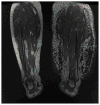Lymphedema and obesity: is there a link?
- PMID: 25028830
- PMCID: PMC4393748
- DOI: 10.1097/PRS.0000000000000268
Lymphedema and obesity: is there a link?
Abstract
Lymphedema is a chronic disorder that, in developed countries, occurs most commonly after lymph node dissection for cancer treatment. Although the pathophysiology of lymphedema is unknown, the disease is characterized histologically by fibrosis and abnormal adipose deposition. Clinical studies have provided evidence that obesity and postoperative weight gain are significant risk factors for the development of lymphedema. In fact, recent studies have shown that extreme obesity can result in markedly impaired lymphatic function and primary lymphedema. The aim of this Special Topic article is to review evidence linking obesity and lymphedema. In addition, the authors review recent studies that have analyzed the cellular mechanisms that may be responsible for this relationship, with a goal of highlighting areas of research that may have significant translational potential.
Conflict of interest statement
Figures



References
-
- Rockson SG, Rivera KK. Estimating the population burden of lymphedema. Ann N Y Acad Sci. 2008;1131:147–154. - PubMed
-
- Rockson SG. Lymphedema. Curr Treat Options Cardiovasc Med. 2006;8:129–136. - PubMed
-
- Brorson H, Ohlin K, Olsson G, Nilsson M. Adipose tissue dominates chronic arm lymphedema following breast cancer: An analysis using volume rendered CT images. Lymphat Res Biol. 2006;4:199–210. - PubMed
-
- Treves N. An evaluation of the etiological factors of lymphedema following radical mastectomy; an analysis of 1,007 cases. Cancer. 1957;10:444–459. - PubMed
-
- Helyer LK, Varnic M, Le LW, Leong W, McCready D. Obesity is a risk factor for developing postoperative lymphedema in breast cancer patients. Breast J. 2010;16:48–54. - PubMed
Publication types
MeSH terms
Grants and funding
LinkOut - more resources
Full Text Sources
Other Literature Sources
Medical

